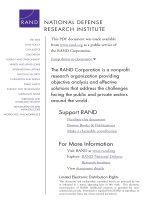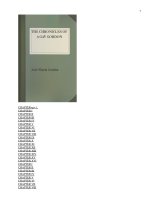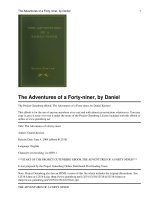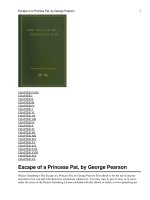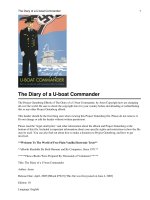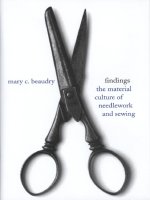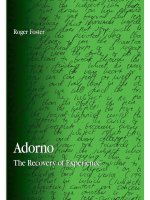auckland university press kohika the archaeology of a late maori lake village sep 2004
Bạn đang xem bản rút gọn của tài liệu. Xem và tải ngay bản đầy đủ của tài liệu tại đây (30.97 MB, 297 trang )
Kohika
Ko whakapaukorero te maunga
Ko Tarawera te awa
Ko Ngati Awa te iwi
Ko Mataatua te waka
Ko Te Kohika te pa
Ko Tupai, Ko Tutarakauika, Ko Te Rangihiiria, Ko Tuara nga taniwha
Ko Matataketake me Tiki nga mauri kohatu
Ko Te Awa o Te Atua te kotore
Ko Otamaroroa te papa whenua
Ko Tamarau te kaitiaki wairua
Ko Te Kaokaoroa te akua
Ko Waimea, Ko Waitepuru, Ko Awatarariki, Ko Awaitipaku, Ko Awaiti,
Ko Omehue, Ko Awakaponga, Ko Te Waikamihi, Ko Mangaone nga awa
Ko Te Otaramuturangi, Ko Tiepataua, Ko Te Awakaponga, Ko Te Ahikokoai,
Ko Awatarerehika, Ko Te Umuhika nga urupa.
Ngati Awa pepeha
Whakapaukorero is the mountain
Tarawera is the river
Ngati Awa is the tribe
Mataatua is the canoe
Te Kohika is the pa
Tupai, Tutarakauika, Te Rangihiiria, and Tuara are the guardians
Matataketake and Tiki are the talismans
Te Awa o Te Atua is the estuary
Otamaroroa is the locality
Tamarau is the spirit guide
Te Kaokaoroa is the coastline
Waimea, Waitepuru, Awatarariki, Awaitipaku, Awaiti, Omehue, Awakaponga,
Te Waikamihi and Mangaone are the streams
Te Otaramuturangi, Tiepataua, Te Awakaponga, Te Ahikokoai, Awatarerehika
and Te Umuhika are the cemeteries.
Ngati Awa proverbial saying
Kohika
The archaeology of a late Maori lake village in
the Ngati Awa rohe
,
Bay of Plenty, New Zealand
Edited by Geoffrey Irwin
Auckland University Press
First published 2004
Auckland University Press
University of Auckland
Private Bag 92019
Auckland, New Zealand
www.auckland.ac.nz/aup
© the authors 2004
ISBN 1 86940 315 0
This book is Memoir 9 of the Whakatane and District Historical Society,
which has provided assistance with its publication.
National Library of New Zealand Cataloguing-in-Publication Data
Kohika : the archaeology of a late Ma¯ori lake village in the Nga¯ti
Awa rohe, Bay of Plenty, New Zealand / edited by Geoffrey Irwin.
Includes bibliographical references and index.
ISBN 1-86940-315-0
1. Ngati Awa (New Zealand people)—Antiquities. 2. Excavations
(Archaeology)—New Zealand—Kohika (Rangitaiki Plains)
3. Kohika Site (N.Z.) I. Irwin, Geoffrey.
993.4201—dc 22
This book is copyright. Apart from fair dealing for the purpose of private study,
research, criticism, or review, as permitted under the Copyright Act, no part may
be reproduced by any process without the prior permission of the publisher.
Designed and typeset by Amy Tansell
Printed by Printlink Ltd, Wellington
Contents
List of tables vi
List of figures vii
List of plates ix
Acknowledgements xiii
1. An introduction to Kohika in historical and archaeological context 1
G.J. Irwin, R.G. Law, I. Lawlor and P. Ngaropo
2. Kohika in the geomorphological context of the Rangitaiki Plains 11
G.J. Irwin
3. The impact of Polynesian settlement on the vegetation of the coastal Bay of Plenty 20
M.S. McGlone and K.L. Jones
4. Excavations and site history at Kohika 45
G.J. Irwin
5. Site chronology 76
G.J. Irwin and M.D. Jones
6. The wooden artefacts from Kohika 83
R.T. Wallace and G.J. Irwin
7. Houses, pataka and woodcarving at Kohika 122
R.T. Wallace, G.J. Irwin and R. Neich
8. Kohika fibrework 149
S. McAra
9. Artefacts of bone, tooth, pumice and pounamu 160
G.J. Irwin
10. Sources of the Kohika obsidian artefacts 168
P.R. Moore
11. The Kohika obsidian artefacts: technology and distribution 177
S.J. Holdaway
12. Faunal remains from Kohika 198
G.J. Irwin, R.K. Nichol, M.A. Taylor, T.H. Worthy and I.W.G. Smith
13. Evidence for diet, parasites, pollen, phytoliths, diatoms and starch grains in
prehistoric coprolites from Kohika 217
G.J. Irwin, M. Horrocks, L.J. Williams, H.J. Hall, M.S. McGlone and S.L. Nichol
14. Kohika as a late northern Maori lake village 239
G.J. Irwin
Appendix Inventory of wooden and fibre items 249
R.T. Wallace and G.J. Irwin
Index 260
vi
List of tables
Table 1.1 Frequency of sites by type in the Rangitaiki Plains and surrounding area
Table 3.1 Radiocarbon dates, Kohika pollen site (Square D17)
Table 5.1 Chronometric data used in the current analysis
Table 5.2 Summary posterior distributions for Phase 2 start, Phase 2 end and Phase 2 duration
Table 6.1 Characteristics of the bird spear fragments
Table 6.2 Comb dimensions (mm)
Table 7.1 Estimated dimensions of excavated houses and pataka
Table 8.1 Single spiral-wrapped bundles of harakeke (1SWB)
Table 8.2 Two-ply spiral-wrapped bundles of harakeke (2PSW)
Table 8.3 Three-ply cordage
Table 8.4 Three-ply braid variants
Table 8.5 Plaited twill with narrow strips
Table 8.6 Plaited check with broad strips
Table 8.7 Netting and component parts
Table 8.8 Other pieces: fragments whose technique is unclear
Table 8.9 Contents of boxes (KOH number and technique)
Table 9.1 Artefacts from Kohika
Table 10.1 Size, roundness and sphericity of Kohika obsidian pebbles
Table 10.2 XRF analyses of obsidian samples from Kohika and Maketu
Table 11.1 Complete flake mean dimensions (and standard deviation) by exterior scar direction
for all areas in the university excavation, Mayor Island obsidian
Table 11.2 Maximum dimension of cores by scar pattern for all areas in the university
excavation, Mayor Island obsidian
Table 11.3 Maximum dimension for proximal, medial and distal fragments by exterior scar
pattern, Mayor Island obsidian
Table 11.4 Complete flake mean dimensions (and standard deviation) from the Historical
Society assemblage by exterior scar pattern, Mayor Island obsidian
Table 11.5 Mean dimensions for complete platform rejuvenation flakes from all areas in the
university excavation, Mayor Island obsidian
Table 11.6 Mean dimensions for complete flakes of length greater than 23 mm, by exterior
scar direction from all areas in the university excavation, Mayor Island obsidian
Table 11.7 Mean dimensions (and standard deviations) of complete tools compared with
complete flakes for all areas in the university excavations, Mayor Island obsidian
Table 11.8 Mean dimensions (and standard deviation) for pieces with macroscopic edge
modification by type for all areas excavated by the university, Mayor Island obsidian
Table 11.9 Mean dimensions (and standard deviation) for complete tools from the Historical
Society assemblage by edge modification type, Mayor Island obsidian
Table 11.10 Frequency of edge-modified pieces, flakes and cores by area, Mayor Island obsidian
Table 11.11 Mean length (and standard deviation) of complete flakes with length > 23 mm by
exterior scar morphology and area, Mayor Island obsidian
Table 11.12 Frequency of complete and fragmented flakes of length > 23 mm by area, Mayor
Island obsidian
Table 11.13 Number and weight of flakes and flake fragments of maximum dimension less
than 10 mm by area, Mayor Island obsidian
Table 11.14 Complete flakes with length > 23 mm from the university excavations compared
with those excavated by the Whakatane Historical Society, Mayor Island obsidian
Table 11.15 Frequency of complete and fragmented tools by type of edge modification and
area
Table 11.16 Length of notched area of edge modification for all notched tools by region
Table 11.17 Maketu and Taupo obsidian technological types
Table 11.18 Proportion of cortex on flakes and edge-modified pieces from all areas, Mayor
Island obsidian
Table 12.1 Minimum number of individual mammals
Table 12.2 Human bone by excavation area
vii
Table 12.3 Dog body parts by excavation area
Table 12.4 Taphonomic variables for identified dog bone by excavated area
Table 12.5 Estimated ages of dogs at death
Table 12.6 Avian taxa represented among identifiable elements in the Kohika assemblage with
data from all squares and layers amalgamated
Table 12.7 Frequencies of fish species, by area
Table 12.8 Fish species frequencies by layer, Area D
Table 12.9 Bone class frequencies for jack mackerel, Area D
Table 12.10 Shellfish from Kohika
Table 12.11 Shell samples from the White House, Area D
Table 12.12 Shell samples from the Yellow House, Area D
Table 12.13 Shell samples from the Bright Yellow floor, Area D
Table 13.1 Samples included in coprolite analyses
Table 13.2 Physical attributes of coprolites analysed
Table 13.3 Components of coprolites, weights and percentages
Table 13.4 Incidence of fish body parts in Kohika coprolites
Table 13.5 Seeds from Kohika coprolites
Table 13.6 Percentages of inorganic material
Table 13.7 Variation in coprolite no.19
List of figures
Figure 1.1 The former river courses of the Rangitaiki Plains and communication routes
recorded in early maps (Gibbons 1990, Hunia 1977)
Figure 1.2 Archaeological sites recorded in the area of the Rangitaiki Plains
Figure 2.1 The geomorphology of the Rangitaiki Plains
Figure 2.2 Former shorelines and river courses on the Rangitaiki Plains
Figure 2.3 Soils of the Rangitaiki Plains in the vicinity of Kohika (after Pullar 1985)
Figure 3.1 The Bay of Plenty lowlands with pollen sites underlined
Figure 3.2 Pollen site stratigraphy: Kohika pollen site (excavation Square D17), Tunapahore
archaeological site complex and Thornton-Atkinson archaeological site
Figure 3.3a Kohika, percentage pollen diagram
Figure 3.3b Kohika, percentage pollen diagram
Figure 3.3c Kohika, percentage pollen diagram
Figure 3.3d Kohika, percentage pollen diagram
Figure 3.4a Thornton-Atkinson complex, percentage pollen diagram
Figure 3.4b Thornton-Atkinson complex, percentage pollen diagram
Figure 3.5 Tunapahore A, percentage pollen diagram
Figure 3.6a Tunapahore B, percentage pollen diagram
Figure 3.6b Tunapahore B, percentage pollen diagram
Figure 4.1 A contour map of Kohika showing the location of the excavations
Figure 4.2 Some representative section drawings from Area A
Figure 4.3 A plan of the excavated features in Area A
Figure 4.4 Square B1, north section
Figure 4.5 Square B1, south section
Figure 4.6 Square B1, plan of features at the base of the excavation
Figure 4.7 Square B3, east section
Figure 4.8 Square B4, west section
Figure 4.9 Square C1, south section
Figure 4.10 Square C1, west section
Figure 4.11 Square C7, south section
Figure 4.12 Square C10, north section
Figure 4.13 Area D, the layout of excavation units
Figure 4.14 Squares D1 and D2, all sections
viii
Figure 4.15 Area D, the White House horizon
Figure 4.16 Area D, the Yellow House horizon (stakeholes less than 10 cm deep are not shown)
Figure 4.17 Area D, the Bright Yellow horizon
Figure 4.18 Area D, Squares D12–15, trench
Figure 4.19 Historical Society investigations (with some of their notes)
Figure 5.1 Summary of the calibrated distributions for the chronometric data given in Table 5.1
Figure 5.2 Posterior distribution for Phase 2, start
Figure 5.3 Phase 2, end
Figure 5.4 Phase 2, duration
Figure 6.1 Bird spear point made from tree-fern trunk
Figure 6.2 Twelve digging sticks and one ko footrest
Figure 6.3 A weeder blade, a one-piece spade, and four handles of composite digging tools
Figure 6.4 Seven complete detachable digging-tool blades, one rough-out and one fragment
Figure 6.5 Part of a carving on a ceremonial ko
Figure 6.6 Seven broken shafts with terminal knobs, possibly handles from composite tools
Figure 6.7 Fifteen beaters and beater fragments
Figure 6.8 Four bowls and bowl fragments
Figure 6.9 A steering paddle rough-out
Figure 6.10 Canoe paddle and paddle fragments
Figure 6.11 Canoe hull pieces
Figure 6.12 Three canoe seats, one bulkhead and eight other fittings
Figure 6.13 Canoe bailers
Figure 6.14 Six heru or hair combs
Figure 6.15 Six darts or javelins
Figure 6.16 Seven potaka or spinning tops
Figure 6.17 An adze handle rough-out
Figure 6.18 A chisel handle and a chisel socket
Figure 6.19 A section of a putorino (flute)
Figure 6.20 Two net gauges
Figure 6.21 Two thread reels
Figure 6.22 Fibre-, net- and rope-working tools
Figure 6.23 Ladder
Figure 6.24 Wood-splitting wedges
Figure 6.25 Pegs
Figure 6.26 Items of unidentified function
Figure 7.1 A reconstruction of the carved house from the Historical Society (HS) Area
Figure 7.2 A reconstruction of the pole and thatch house from the Yellow House floor, Area D
Figure 7.3 A reconstruction of the pataka from Area D
Figure 7.4 Types of lashing holes on house planks
Figure 7.5 Poupou and other vertical house elements from the HS Area
Figure 7.6 Door or window parts from the HS Area
Figure 7.7 Tumatahuki battens from the HS Area
Figure 7.8 Possible fragments of pataka from the HS Area
Figure 7.9 Dressed slabs split from pukatea tree trunks, HS Area and Area B
Figure 7.10 Timbers recovered from Area D
Figure 7.11 The three rafters from Area D
Figure 7.12 Detail of rafter tenon joints
Figure 7.13 Parameters used to estimate the width of a building in Area D, based on rafter
dimensions
Figure 7.14 Two parts of pataka from Area D, plus two indeterminate items (KOH30 and 31)
Figure 7.15 Detail of the internal and external framing of a superior house
Figure 8.1a KOH298. Drawing of two-ply spiral-wrapped bunches of harakeke (2PSW)
Figure 8.1b Diagram of technique for making 2PSW
Figure 9.1 Bone hei tiki pendant, tooth pendant, bone toggle
Figure 9.2 Pounamu adze
ix
Figure 9.3 Pumice kumara god
Figure 10.1 Dimensions of obsidian pebbles from Kohika, Maketu and Otamarakau
Figure 10.2 Rb-Sr plots for analysed obsidian artefacts from Kohika (solid symbols) and source
samples from Maketu and Taupo
Figure 10.3 Zr-Rb plots for analysed obsidian artefacts from Kohika (solid symbols) and source
samples from Maketu and Taupo
Figure 10.4 Relative proportions of ‘grey pebble-type’ and ‘other grey’ obsidian from Kohika
Figure 11.1 Terms used to describe flake fragments. Proximal flakes include a platform, distal
flakes have a termination, and medial flakes lack a platform or a termination
Figure 11.2 Flakes with different exterior scar patterns. The identification numbers are given
in brackets: a (1703), b (1637), uni-directional; c (1907), d (1735), bi-directional;
e (1893), sub-radial; f (1688), radial
Figure 11.3 Quadrants for assessing scar orientation. The flake is orientated with the platform
at quadrant 1 (the figure is based on artefact 161)
Figure 11.4 Typology for edge modification: a (2617), b (2163), bifacial; c (2128), heavy;
d (1145), e (1687), f (2175), g (1850), light; h (2490), i and j (1822), k (1635),
notch
Figure 11.5 Dimensions of a complete flake
Figure 11.6 Core shapes: a (1525), pebble; b (1747), c (2248), multiple platform; d (2875),
e (3179), flake; f (2878), radial
Figure 11.7 Platform preparation flakes and flakes with two interior surfaces: a (2882),
b (2491), c (1589), d (1752) and e (1588)
Figure 11.8 Large flakes from Historical Society: a (94), b (96), c (150), d (161), e (98) and
f (158)
Figure 12.1 Size frequency distributions of snapper, kahawai and jack mackerel, Area D
Figure 12.2 Size frequency distributions of jack mackerel by layer, Area D
Figure 12.3 Size frequency distributions of pipi and tuatua, Area D
Figure 13.1 Components of Kohika coprolite samples, percentages by weight
Figure 13.2 Percentage pollen diagram for Kohika coprolite samples
Figure 13.3 Percentage phytolith diagram for Kohika coprolite samples
Figure 13.4 Percentage diatom diagram for Kohika coprolite samples
Figure 14.1 A schematic view northwards over Area D across the lake to the dunes and the
sea. In the left foreground is a reconstruction of Area D during the Yellow House
horizon. The houses, canoes, nets and racks on the right represent the artefacts
and building timbers found in the Historical Society Area. The palisade follows
the topography around the lake. The lakeshore vegetation of raupo, flax and
cabbage trees with patches of kahikatea and kanuka scrub is based on the pollen
record. The roofed pit and two small covered bins in the bottom right were actually
found in Area A.
List of plates
Plate 1.1 In 1975, Kohika was an inconspicuous, low-lying grassed mound in an area of
agricultural swamp drainage.
Plate 1.2 A whakanoa ceremony was conducted by Jack Fox, Romana Kingi, Mike Mason,
Harry Reneti and Albert Te Rere, of the Ratana, Anglican, Catholic, Ringatu and
Presbyterian churches respectively. The kaumatua placed the site and the artefacts
into the interim care of the University of Auckland.
Plate 1.3 After the discovery of artefacts, the first investigations were undertaken by mem-
bers of the Whakatane and District Historical Society. In this 1976 photograph
are (from left) Dave White, Ken Moore and the late Anton van der Wouden. The
spoil in the background was removed from the drain by a digging machine.
Plate 1.4 The University of Auckland excavations of Area D during the season of January,
1976.
x
Plate 2.1 The new mouth of the Tarawera River. The former course of the Rangitaiki
River is at the left of the entrance and the former Te Awa o te Atua estuary, which
carried the combined waters of the two rivers, lay to the right of the entrance and
flowed west to Matata. The current road bridge is on the Kaharoa shoreline, and
a short distance upstream is the junction of the Tarawera and the Awaiti Stream.
Canal 109 runs inland from the Awaiti past the remains of Lake Kohika.
Plate 2.2 Looking seawards, a canal and stopbank now separate Lake Kohika from the
archaeological lake village, which formerly lay on its southwestern shore. The
site itself is located on a remnant of sand-dune that dates from the coastline of
2000 years ago. The archaeological excavation can be seen at the end of the
farmer’s cattle-race.
Plate 4.1 Kohika in January 1976. Work is in progress in Areas A, B and D. The spoil
heaps are of different colour, which results from their varied composition.
Plate 4.2 Excavations in Square A1 Extension.
Plate 4.3 Part of a small bin surrounded by surface stakeholes in Square A3.
Plate 4.4 A cross-section of a bin structure in Square A3 dug into the former sand-dune.
Plate 4.5 An oval-ended pit in Square A1 Ext. interrupted by a later rectangular pit lying at
right angles to it. A charcoal sample for C14 dating was taken from underneath
the large pumice boulder found in the pit fill.
Plate 4.6 Square B1 during excavation.
Plate 4.7 Square B1 near the base of the excavation showing in situ posts.
Plate 4.8 The drain section in Area B shows a flood deposit of reworked tephra alluvium
outside the site, where a later meander channel, visible in Square B3, has cut into
its surface.
Plate 4.9 Wooden items from the peat below the flood deposit in Square B3 are triple-bagged
in plastic.
Plate 4.10 A degraded pukatea board in the upper peat of Square B4.
Plate 4.11 The pukatea board in Square B4 consolidated prior to removal.
Plate 4.12 The defended edge of the site was sharply defined in Square B4. Palisade posts
were exposed in the side of the agricultural drain visible in the background and
Square B3 lies on the other side of it.
Plate 4.13 The edge of the site reveals the effect of the flood in Square B4. Fine silt lies around
the palisade posts, reworked Kaharoa alluvium lies outside the site, and the two
are separated by the wave-lapped shore.
Plate 4.14 Square B4, west section, showing a palisade post, pre-flood deposits that built up
during occupation, the flood alluvium of sand and silt, and post-flood sediments
that are culturally sterile.
Plate 4.15 Squares C1 and C12 reveal a deposit of alluvium. Above this, a late meander
channel in the Upper Peat can be seen in the baulk, while below the alluvium is
the culture-bearing Lower Peat. This photograph shows the pump being primed
in 1975 at the start of a day’s work.
Plate 4.16 Square C10 contained a complex succession of fire-pits and hangi with occupational
debris and fills composed of material quarried elsewhere.
Plate 4.17 Excavating a swamp in wet weather can have its difficulties. Area D.
Plate 4.18 The site perimeter in Area D. Inside the line of posts were artificial house floors;
outside many associated waterlogged artefacts were found preserved in peat.
Plate 4.19 Square D2, with superimposed house floors visible in the south section.
Plate 4.20 Square D2. A line of standing posts, with horizontal light wooden battens flexed
and pegged between them, marks the edge of an artificial floor of silt, packed
with water-rolled greywacke pebbles.
Plate 4.21 Square D1, south section. Also showing a test excavation of the lacustrine silt, the
Kaharoa Tephra and sedge peat below.
Plate 4.22 Square D5, the White House floor.
Plate 4.23 Square D4, firescoops in the White House horizon.
Plate 4.24 Area D, exposing the extent of the Yellow House horizon, January 1976.
xi
Plate 4.25 Area D, some details of the excavation of the Yellow House floor.
Plate 4.26 Area D, Square DD during excavation of the Yellow House horizon. Intruding
into the square is the corner of Square D2, dug previously, while the baulks are
composed of backfilled spoil.
Plate 4.27 Square DD, laid bracken-fern stems below an artificial house floor.
Plate 4.28 Square D2, canoe bow in peat.
Plate 4.29 Square D2, gourd shell.
Plate 4.30 Square D2, adzed log and length of rope.
Plate 4.31 Square D7, whale vertebra, wooden spear and coil of vine.
Plate 4.32 Square D13, north section.
Plate 4.33 Square D14, log at base of excavation.
Plate 6.1 Thirteen sections of bird spear and one spear point.
Plate 6.2 Two coils of rata vine.
Plate 7.1 KOH14. Poupou base, Historical Society Area.
Plate 7.2 KOH16. Poupou base, Historical Society Area.
Plate 7.3 KOH17. Poupou base, Historical Society Area.
Plate 7.4 KOH18. Poupou base, Historical Society Area.
Plate 7.5 KOH44. Poutahuhu base, Historical Society Area.
Plate 7.6 KOH53. Pare fragment, Historical Society Area.
Plate 7.7 KOH1. Part of carving, Historical Society Area.
Plate 7.8 KOH3. Fragment of carving, Historical Society Area.
Plate 7.9 KOH345. Fragment of spiral from carving, Historical Society Area.
Plate 7.10 KOH7. Poutokomanawa figure, Historical Society Area, and modern replica carved
by Paki Harrison, Dante Bonica and Wiremu Puke.
Plate 7.11 KOH2. Fragment of elaborate carving, Area D.
Plate 7.12 KOH6. Fragment of elaborate carving, Area D.
Plate 7.13 KOH4. Fragment of elaborate carving, Area D.
Plate 7.14 KOH174. Carved handle of bailer, Area D.
Plate 8.1a KOH298.5. Fragment of single spiral-wrapped bunches of harakeke (1SWB)
resembling a handle.
Plate 8.1b KOH300.3. Fragment of 1SWB resembling one half of a pair of two-ply spiral-
wrapped bunches (2PSW) of harakeke.
Plate 8.1c KOH298.1. Short fragment of two-ply spiral-wrapped bundles of harakeke (2PSW).
Plate 8.2 KOH303.8–11. Short braided fragments, showing two straight examples
(KOH303.8 and 9) and an X and a Y braid (KOH303.10 and 11).
Plate 8.3 KOH304.1. Fine twill close-up, showing condition of fibres.
Plate 8.4 KOH305.1. A larger piece of fine twill, showing the curvature in the plaiting.
Plate 8.5 KOH303.4. Broad checked plaiting, showing one folded-back strip (at lower part
of image).
Plate 8.6a KOH297. A Grommet with netting still attached.
Plate 8.6b KOH297. Small fragment of mesh.
Plate 9.1a Greenstone kuru pendant.
Plate 9.1b Greenstone chisel pendant.
Plate 9.2 Bone tiki pendant (human).
Plate 9.3a–c One-piece bone fishhooks (human).
Plate 9.4a Bone fishhook blank (human).
Plate 9.4b Fishhook point (dog tooth).
Plate 9.5a Bone needle (bird).
Plate 9.5b Bone needle (dog).
Plate 9.5c Bone awl (bird).
Plate 9.6a Bone awl (seal).
Plate 9.6b Bone chisel (dog).
Plate 9.7 Pounamu adze.
Plate 9.8a Pounamu chisel.
Plate 9.8b Pounamu adze flake.
xii
Plate 9.9a Sandstone file.
Plate 9.9b Pumice pigment bowl.
Plate 12.1 A sawn section of human cranium.
Plate 12.2 Knife-cut marks on a human femur.
Plate 12.3 Dog cranium with crushed parietal.
Plate 12.4 Dog cranium with cut marks on nasal bone.
Plate 12.5 Dog mandible with ventral margin removed.
Plate 12.6 Dog-tooth marks on snapper bones and barracouta jaw.
Plate 13.1 Examples of coprolites from Kohika.
Plate 13.2 Fishbone extracted from coprolite no.24.
Plate 13.3 Charcoal extracted from coprolite no.19.
Plate 13.4 Egg of Toxocara canis.
Plate 13.5 Egg of Toxocara canis, showing characteristic pitting of the shell.
Plate 13.6 Egg of Capillaria hepatica.
xiii
Acknowledgements
For over 30 years this project has accumulated a huge debt to many individuals, some
of whom have now passed on, and to many institutions. The whakanoa ceremony at
the site was conducted by Jack Fox, Romana Kingi, Mike Mason, Harry Reneti and
Albert Te Rere. Professor Hirini Mead, Pouroto Ngaropo and Ngahuia Rawson of Te
Runanga o Ngati Awa provided guidance for the return of the Kohika artefacts and
for their future.
Members of the Whakatane and District Historical Society who first worked at
Kohika and then gave generous support to the University of Auckland team included
Tiena Jordan, Jack Moller, Ken Moore, Dave White, Errol Westgate and Anton van
der Wouden, who was also director of the Whakatane District Museum and Gallery.
A later director, Warner Haldane, helped arrange the return of the artefacts to
Whakatane.
At Kohika, the farmer, Phil Jessop, and the sharemilkers, Les and Graeme Brownlee,
could not have been more obliging. Neighbouring farmers, especially Tony Pansier,
helped to house the excavators and made gifts of food. The Rangitaiki Plains Dairy
Company provided us with showers and evening meals during one winter season.
Institutional support and funding was provided by the Department of Anthropol-
ogy, University of Auckland, the University of Auckland Research Committee, the
Lotteries Board of the Department of Internal Affairs, and the New Zealand Historic
Places Trust.
All of the scholars who contributed to the analysis of archaeological material are
named in the list of contents of the book. Technical staff at the university made a
magnificent contribution over the years: they include Karel Peters, Rod Wallace and
Dilys Johns for conservation; Joan Lawrence, Caroline Phillips and Seline McNamee
for illustrations; and Tim Mackrell and Hamish MacDonald for photography. A num-
ber of anthropology students carried out preliminary study for research essays and
theses, as described in the book.
Those friends, colleagues and students who took part in the excavations at Kohika
include Harry Allen, Nola Arthur, Barry Baquie, Gary Barnett, Mark Bellingham, Simon
Best, Steve Black, Joanna Boileau, Dorothy Brown, Ken Burnett, Linda Burnett, Richard
Cassels, Helen Charters, John Coster, Mark de Courcy, Marlene Deans, Sandra Dreifus,
Clare Fawsett, Anne Geelen, Roger Green, Don Hanson, Terry Hunt, Joan Hunter, Jill
Irwin, Gabrielle Johnston, Garry Law, Ian Lawlor, Jennifer Leighton, Steve Mangan,
Bernadine Naus, Tia Negerevich, Mary Newman, Reg Nichol, Peter Pearce, Karel Peters,
Caroline Phillips, Michelle Phillips, Pamela Raspe, Pamela Russell, Peter Russell, Bill
Shaw, David Stowe, Jan Stowe, Julie Stretton, Doug Sutton, Makiuti Tongia, Alan
Walmsley, Graeme Ward, Tony Walton and Lynnette Williams. Apologies to anyone
who has been overlooked.
The quality of this book has been greatly improved by Janet Davidson, who carefully
xiv
read and commented on earlier drafts, and Andrew Mason who edited the text. I am
grateful to Elizabeth Caffin and the staff of Auckland University Press including Annie
Irving, Katrina Duncan and Amy Tansell. Diane Lowther compiled the index.
The project would not have been possible without the support of the Irwin family.
Jill made sure the excavation was fed, Sarah and Kate kept watch on the spoil heaps
to see that nothing of value was carelessly thrown away, and Tom took his first steps
at Kohika.
Geoffrey Irwin
1
1 An introduction to Kohika in historical
and archaeological context
G.J. Irwin, R.G. Law, I. Lawlor and P. Ngaropo
Archaeological sites in wetlands are unusually rich because they can preserve organic
materials that rarely survive elsewhere. These include all kinds of wooden artefacts,
fabrics, food remains, and microfossils that indicate former environments. In their
published Rhind Lectures for 1995, J. and B. Coles wrote (1996:133): ‘. . . the wet-
lands of the world have continued to yield new and often surprising information about
the past . . . wetlands have continued to produce archaeological evidence unobtainable
from any other environment save the most extreme.’ However, such sites are increasingly
rare as wetlands are drained.
For Polynesia, Kirch and Green (2001:199–200) estimate that about 20 per cent of
material objects were archaeologically durable and the remaining 80 per cent perish-
able, except in unusual circumstances. This is based on ethnographic inventories of
material culture and lexical reconstructions of the names for artefacts. These cir-
cumstances apply generally to New Zealand. However, while wet sites offer huge
opportunities for research, considerable analytical sophistication and resources are
needed to investigate and preserve them. It is in such a context that this 30-year arch-
aeological wetland study reaches publication.
At some time around AD 1700, a Maori lake village called Kohika in the Bay of
Plenty was abandoned after a flood and fortuitously preserved in peat swamp, together
with its contents. It was rediscovered during agricultural drainage in 1974. The site
was excavated during the late 1970s and produced a rare and comprehensive inventory
of waterlogged remains that are in close association with one another and, as such,
represent a technological, economic and cultural entity. The site is of fairly short
duration and provides an archaeological snapshot of Maori material culture and the
way of life that had developed in the North Island prior to the arrival and influence of
Europeans. Although there have been previous excavations of wetland sites in New
Zealand, none has produced as much rich and varied material as Kohika and had the
benefit of such a range of modern specialist analysis.
Kohika is located in the west of the Rangitaiki Plains in what was formerly a great
swamp. It is just a few hundred metres east of the Tarawera River and two kilometres
inland from the sea. It takes its name from the adjoining Lake Kohika, which lies in
the fork of the Tarawera River and Awaiti Stream (Fig. 1.1). A little further downstream
the Rangitaiki River formerly joined the Tarawera to form Te Awa o Te Atua, a river
estuary that ran three kilometres further westwards behind the coastal dunes to flow
into the sea near the present settlement of Matata. The site had good access to the
resources of swamp, floodplain and coast. It was strategically located for coastal
communication by canoe, and also by river and track to the interior of the North
Island; there is evidence for travel and trade in both directions.
Kohika was a palisaded village on a small island in the swamp beside the lake,
2 Kohika
which was larger then than now. Preserved in the swamp are organic remains that give
detailed information about former environments and diet. The site has archaeological
evidence for a broad range of domestic and social activities. There were houses of
varied construction, including the remains of what is currently the oldest-known carved
house in New Zealand. There were raised pataka storehouses that have long been
elusive in prehistory, plus cooking shelters and semi-subterranean storage pits and bins.
In addition to the remarkable inventory of wooden artefacts, there are fibre plaiting,
cordage and netting, a large assemblage of flaked obsidian and some miscellaneous
artefacts of other materials. The remains reveal many aspects of life, including housing,
canoe transport, food production, craft activities, defence and outside communica-
tion. There is evidence for music, play, personal status, art and religion.
This book contains contributions from 20 scholars, and the various chapters deal
with geomorphology, vegetation history, excavation, chronology, wooden artefacts,
houses and pataka, fibre work, artefacts of bone, pumice and pounamu, obsidian
sourcing, obsidian flake technology, faunal remains and coprolite analysis, followed
by a general review of the evidence. The rest of this chapter includes a brief account of
Figure 1.1
The former river
courses of the
Rangitaiki Plains
and communi-
cation routes
recorded in early
maps (Gibbons
1990, Hunia
1977)
An introduction to Kohika in historical and archaeological context 3
traditional and historical records of Kohika, and a review of archaeological site
distribution in this part of the Bay of Plenty. It concludes with a brief history of the
archaeological project since 1975, and negotiations that vested ownership of the
artefacts with Ngati Awa.
Kohika in history and tradition
According to Ngati Awa oral tradition, a man called Waitahaarikikore, who was des-
cended from Toi and his wife Te Kuraimonoa, lived on Rarotonga. He built a canoe
using the maihi (barge-boards) from his meeting house and called the waka Te Paepae
ki Rarotonga, which he sailed via the Kermadecs to the Bay of Plenty. He lived for a
time near the mouth of the Tarawera River at a place now called Te Otaramuturangi.
Before moving on, he buried the canoe there and, looking southwards across the
swamplands, said: ‘Te ko hika tera’. ‘Over there is the place I shall light my fires’. By
lighting his fires, Waitahaarikikore claimed mana whenua over the place now called
Kohika (Anon. 2000:2).
More recently, the wider Rangitaiki floodplain was the land of Ngati Awa and sec-
tions of Te Arawa and Tuwharetoa. While the area is generally recognised as being
Ngati Awa, the other tribes have ‘historical and land affiliations to the area . . .’ (Hunia
1977:x). The location of Kohika, near Matata, is now in the rohe of Ngati Awa but
its traditional history is complex (Best 1925:690, Grace 1959:90–1, Gudgeon 1970:8,
Lawlor 1979:17–22). The tribal history has fluid relationships and the missionary T.S.
Grace refers in his diaries to connections between Maori he met in the Rangitaiki
Swamp and Lake Taupo (Grace 1928:132, Grace MS 1850–73, Feb. 1867). The three
rivers crossing the plain, the Rangitaiki, Tarawera and Whakatane, plus foot trails,
provided access to Rotorua and the central North Island.
Europeans came late to the Rangitaiki Plains and included traders, missionaries
and soldiers (Lawlor 1979:22–8, see also London 1960). One description of condi-
tions and communications in the swamp is by Cowan (1923:96):
This Rangitaiki Swamp . . . was then accessible only by the tracks along the sea-
ward sandhills, or by canoe along the Tarawera River, the Awaiti-Paku, and the
Orini River (connecting the Awa-a-te-Atua with Whakatane Harbour) and by the
labyrinth of reed-fringed waterways, navigable in small canoes, winding among
the islets that rose above the water a few feet and made camping-grounds for eel-
fishers and wild fowl hunters.
Cowan speaks of palisaded ‘island-like forts in the great swamp’ during the military
operations of the 1860s (Cowan 1923:96). Two historic pa close to Kohika were Oheu
and Te Matapihi, on the west bank of the Tarawera, the latter being where the Rev.
T.S. Grace built a storehouse and landing-stage to service his inland mission to Taupo.
The village of Matata was sketched in 1865 by H.G. Robley (MS 1858–87:14, MS
1898–1922). It was then on the east bank of the Tarawera at its junction with the
Rangitaiki River (Fig. 1.1) but shifted to its present location after the land confiscations.
Kohika was a prehistoric forerunner to these musket pa, not simply as a fort but as a
site of substantial settlement.
We have found only two specific references to Kohika. One is in a note at the end
of Cowan’s chapter on military operations at Matata, where he quotes Mr F. Burt,
who for many years farmed the Matapihi Block at Matata: ‘The natives tell me when
they were spearing eels near the Kohika Lake they came across the remains of an old
4 Kohika
pa, so there was evidently one between Oheu and the Kohika’ (Cowan 1923:105). In
addition, the record of a misadventure in the swamp by the Rev. T.S. Grace around
1860 indicates that Lake Kohika could be reached from the main streams (Grace
1928:133).
The experience of the first Europeans to settle in the Rangitaiki Swamp gives a
useful insight into the conditions in prehistoric times. Government survey for settle-
ment began in 1890 and allotments were taken up. Then, in 1892, a flood filled the
swamp with water and it looked like an inland lake behind the coastal sandhills for
several years, and many settlers abandoned the area (Gibbons 1990:vii, 10–11). The
first drainage board was formed in 1894, the Rangitaiki was diverted to its new mouth
in 1914 and the Tarawera in 1924 (Pullar 1985:8). Once drained, the Rangitaiki Plains
became highly suited to dairy farming.
Archaeological site distribution in the area of the Rangitaiki Plains
The Bay of Plenty enjoys a warm, moist climate and fertile soils ideal for horticulture.
Together with its fisheries and forests, it offered ideal conditions for Maori settlement.
Figure 1.2
Archaeological
sites recorded in
the area of the
Rangitaiki Plains
An introduction to Kohika in historical and archaeological context 5
The following account provides an archaeological context for discussing the location
of Kohika.
Recording of Maori archaeological sites in the area began in the 1960s and was
carried on for the next two decades principally by Kawerau resident Ken Moore.
Surveying in the Whakatane and Waimana river areas was done by the New Zealand
Historic Places Trust in the early 1980s. Other contributions have come from forestry
surveys and research and heritage management work at Ohiwa, Moutohora and
Kawerau (Hayward et al. 1987, Jones 1983, 1984, 1986, 1991, Lawlor 1983a, 1983b,
Moore 1973, 1974, 1980a, 1980b, Phillips 1996).
Figure 1.2 plots the recorded Maori sites in the area in the New Zealand Archaeo-
logical Association Site Recording Scheme, as at February 2002. For this plot the sites
were extracted in a hierarchical manner from the Computerised Index of New Zea-
land Archaeological Sites (CINZAS), using the site description field. The site type in
this field is not necessarily the same as on the site record form but represents a more
consistent approach to setting a site type than is often found on the form. The number
of sites in Figure 1.2 is shown in Table 1.1 using the same system for classification.
The site distribution in Figure 1.2 shows the broad patterns of Maori settlement.
Pa are concentrated on higher ground along the coast, around Ohiwa Harbour and
on the ridges at the periphery of the Rangitaiki Plains and Whakatane River. Kohika
(V15/80) is the only site recorded as a swamp pa in the area, and the other pa shown
on the plains close by belong to the historic period.
Terraces are the most common site type and are concentrated in the vicinity of
Kawerau and Ohiwa, although this could be partly the result of surveys being more
thorough there than elsewhere. Pit sites may be underrepresented in the southwestern
part of Figure 1.2, which was blanketed by tephra from the 1886 Tarawera eruption
that filled many pits on terrace sites (Lawlor 1983a:220).
Rua, while known from excavations, are rare as field recorded sites, unlike further
west in the Bay of Plenty. However, in the Other category there are sites cautiously
described as ‘depressions’ which may be collapsed rua. This low frequency may result
Table 1.1 Frequency of sites by type in the Rangitaiki Plains and surrounding area
Site type Number in area
Pa 288
Terrace sites 410
Pit sites 120
Rua 1
Middens 175
Spot finds 4
Ovens 6
Cultivated soil 6
Other 38
Total 1048
Notes:
• Pa are sites with that site description.
• Terrace sites are those with terraces in their description that are not pa. They may also be sites with
middens, pits, etc.
• Pit sites are those with pits in their description, but not pa or terraces. They may also be sites with
middens, etc.
• Rua are sites with cave pits in their description, but not the above.
• Middens do not include any of the categories above.
• Other sites are those coded as Maori. An unusual site is a large grinding stone at Matata (Fulton
1921).
6 Kohika
from the inability of the local natural soils to sustain open rua. Again, in comparison
with the western Bay of Plenty, records of cultivation soils are few.
Middens are few along the coast west of Matata, which can be attributed to the
fact that few soft shore species live in a high-energy beach environment. Along the
coast of the Rangitaiki Plains the records are still few, even though there are more
estuaries and the beach environment is more conducive to sandy shore species. Local
investigations have certainly revealed middens (Jones 1991, Shawcross 1965) and the
apparent scarcity could be corrected by further recording.
In general, the Rangitaiki Plains have a low site density compared with surround-
ing areas. However, underrecording may be an issue, and the Tarawera Tephra and
outwash will have buried some sites. Much of the seaward part of the plains was
swamp in the early 19th century and had clearly been so for centuries, as indicated by
the growth of peat. Only raised areas in the swamp would have been attractive for
Maori settlement, and Jones (1991) recorded cultivation sites on the beach ridges left
stranded by the prograding coastline, as well as on the better-drained river fans in the
southern part of the plains. A number of lowland sites have produced wooden artefacts
(Mead 1984:200).
In general, the site distribution shows the preference of Maori to live along the
coast, especially near harbours. Away from the coast, sites are concentrated on soils
attractive to Maori horticulturalists and areas enjoying both defensible uplands and
access to rivers. Kohika is unusual in the context of the larger sample of sites, being a
prehistoric lowland swamp pa in an area with a very low density of recorded sites.
A brief history of the investigations since 1975
The site was discovered in November 1974 during drainage operations near Lake
Kohika at the swampy northern end of the farm of Mr P. Jessop of Sutherlands Rd. A
digging machine exposed a palisade of kanuka posts in the side of a drain on the
eastern side of the site, and various wooden and other artefacts were thrown out with
the spoil. During the summer of 1974–75, members of the Whakatane and District
Historical Society investigated quite a large area of swamp on the northern side of the
site by probing. They dug up many valuable wooden artefacts which were placed in
water for safekeeping.
The New Zealand Historic Places Trust became involved, and the site was visited in
early 1975 by Auckland archaeologists. It was agreed that G. Irwin, who had previously
worked at swamp pa in the Waikato excavated by staff of the University of Auckland
(Bellwood 1978, Shawcross 1968), would direct an excavation as a University of Auck-
land project with a grant from the Golden Kiwi Lottery Board (Irwin 1975, Moore
1975). At this time there was little understanding of the site’s complexity, size or
significance.
A series of major excavations took place in May 1975, January 1976, December
1977 and April 1978, and further fieldwork to resolve particular issues was done in
1979 and 1981 (see Plates 1.1–4). A large-capacity pumping system was developed
together with on-site conservation. The fieldwork gradually came to terms with the
complex geomorphology and site stratigraphy and, increasingly, the research design
became interdisciplinary.
Large quantities of archaeological material and other samples were taken to Auck-
land (in a railway wagon after the 1976 season), but there was no conservation
infrastructure waiting to receive them. Waterlogged artefacts were put into temporary
tanks while a conservation laboratory was built and equipped in the new Human
Plate 1.1 In 1975, Kohika was an inconspicuous, low-lying grassed mound in an area of agricultural swamp drainage.
Plate 1.2 A whakanoa ceremony was conducted by Jack Fox, Romana Kingi, Mike Mason, Harry Reneti and Albert Te Rere, of the Ratana,
Anglican, Catholic, Ringatu and Presbyterian churches respectively. The kaumatua placed the site and the artefacts into the interim care of the
University of Auckland.
Plate 1.3 After the discovery of artefacts, the first investigations were undertaken by members of the Whakatane and District Historical Society.
In this 1976 photograph are (from left) Dave White, Ken Moore and the late Anton van der Wouden. The spoil in the background was removed from
the drain by a digging machine.
Plate 1.4 The University of Auckland excavations of Area D during the season of January 1976.
An introduction to Kohika in historical and archaeological context 9
Sciences Building at the University of Auckland. Conservation took many years. The
analysis (and re-analysis) of archaeological materials followed and many researchers
were involved, as described in the following chapters. Several specialist studies were
carried out in the late 1990s, and this full report was written from 2000.
G. Irwin returned the Kohika artefacts to the Bay of Plenty in May 1998,
accompanied by P. Ngaropo, representing a Ngati Awa hapu closely connected with
Kohika. The taonga were first acknowledged at Te Umuhika Marae, Matata, before
being formally welcomed in Whakatane by representatives of the several iwi of the
region, the Bay of Plenty Regional Council, the Whakatane and District Historical
Society and the Whakatane and District Museum and Gallery. The few remaining
artefacts were returned to Whakatane in the care of P. Ngaropo in 1999. The final
artefact, a pounamu adze, is to be presented to Ngati Awa together with a copy of
this book.
The Kohika Collection presented some complex ownership issues. Initially the
landowner, P. Jessop, gave to the Whakatane and District Historical Society, the arte-
facts excavated by its members. When the Department of Anthropology at the University
of Auckland took over direction of the project in 1975, the whole collection was placed
in its interim care at a whakanoa ceremony by kaumatua representing local iwi and
religious denominations. After its return, ownership of the collection was negotiated
between Ngati Awa and the Whakatane and District Historical Society, who had been
responsible for recovering the early part of the collection. The issues were resolved by
the appointment of a board of trustees to manage the collection, comprising a majority
of Ngati Awa representatives as well as a representative each from Ngati Tuwharetoa
ki Kawerau and the Whakatane and District Historical Society, in recognition of their
associations with the collection. The trustees have placed the Kohika Collection on
loan to the Whakatane District Museum and Gallery.
In June and July 2000, an exhibition entitled Kohika: a glimpse of life in a wetland
pa near Matata, was held at Whakatane museum.
References
Anon., 2000. Te Kohika: a glimpse of life in a wetland pa near Matata during the 1600s AD.
Pamphlet prepared for the exhibition at Whakatane and District Museum and Gallery, Te
Whare Taonga o te Rohe o Whakatane, 1 June–16 July, 2000.
Bellwood, P.S., 1978. Archaeological research at Lake Mangakaware, Waikato, 1968–1970.
New Zealand Archaeological Association Monograph No.9.
Best, E., 1925. Tuhoe, the children of the mist. New Plymouth: The Polynesian Society.
Coles, J. and B. Coles, 1996. Enlarging the past: the contribution of wetland archaeology.
Society of Antiquaries of Scotland Monograph Series No.11. Exeter: Short Run Press.
Cowan, J., 1923. The New Zealand Wars: a history of the Maori campaigns and the pioneer-
ing period. Vol. II. Wellington: R.E. Owen, Government Printer.
Fulton, R., 1921. An account of a supposed Maori sharpening stone. Transactions of the New
Zealand Institute, 53:471–2.
Gibbons, W.H., 1990. The Rangitaiki, 1890–1990: settlement and drainage on the Rangitaiki.
Whakatane: Whakatane and District Historical Society.
Grace, J. Te H., 1959. Tuwharetoa: the history of the Maori people in the Taupo district.
Wellington: Reed.
Grace, T.S., 1928. A pioneer missionary among the Maoris 1850–1879: being letters and journals
of Thomas Samuel Grace. Edited by S.J. Brittan, G.F., C.W. and A.V. Grace. Palmerston
North: Bennett.
Grace, T.S., MS Papers 191, Mission work Taupo and Tauranga, 1850–73. Alexander Turnbull
Library.
10 Kohika
Gudgeon, W.E., 1970. Te heke o Rangihouhiri. Whakatane: Whakatane and District Historical
Society.
Hayward, B.W., P.R. Moore and P. Bain, 1987. Prehistoric archaeological sites on Whale Island
(Motuhora), Bay of Plenty. Tane, 32:73–86.
Hunia, L.Te A., 1977. Tangi Putauaki: a Maori history of the Rangitaiki. Unpublished MA
thesis, University of Auckland.
Irwin, G.J., 1975. The Kohika site, Bay of Plenty. Historical Review, 23:101–4.
Jones, K.L., 1983. Pa in two western segments of the Waiotahi and Whakatane Valleys, Bay
of Plenty. New Zealand Archaeological Association Newsletter, 26:165–73.
Jones, K.L., 1984. Archaeological investigations in Waiotahi Valley, Bay of Plenty, November
1981. New Zealand Archaeological Association Newsletter, 27:109–18.
Jones, K.L., 1986. Polynesian settlement and horticulture in two river catchments of the east-
ern North Island, New Zealand. New Zealand Journal of Archaeology, 8:5–31.
Jones, K.L., 1991. Maori settlement and horticulture on Rangitaiki Plains, Bay of Plenty,
New Zealand. New Zealand Journal of Archaeology, 13:143–75.
Kirch, P.V. and R.C. Green, 2000. Hawaiki, Ancestral Polynesia: an essay in historical
anthropology. Cambridge: Cambridge University Press.
Lawlor, I., 1979. Palaeoenvironment analysis: an appraisal of the prehistoric environment of
the Kohika swamp pa (N68/140), Bay of Plenty. Unpublished MA thesis, University of
Auckland.
Lawlor, I., 1983a. Rua Kumara o Kawerau. In S. Bulmer, G. Law and D. Sutton (eds), A lot of
spadework to be done: essays in honour of Lady Aileen Fox. New Zealand Archaeological
Association Monograph No.14, pp.212–48.
Lawlor, I., 1983b. Maruka investigations, Kawerau, Bay of Plenty: Final Report for Stage IV.
Department of Anthropology, University of Auckland.
London, H.D., 1960. A field day at Matata. Historical Review, 8:109–14.
Mead, S.M., 1984. Te Maori: Maori art from New Zealand collections. Auckland: Heinemann.
Moore, K.W., 1973. Archaeology at Whakatane, N.Z. Part 1. Historical Review, 21:113–22.
Moore, K.W., 1974. Archaeology at Whakatane, N.Z. Part 2. Historical Review, 22:50–63.
Moore, K.W., 1975. Kohika site, N68/140, Bay of Plenty: a preliminary report. Historical Review,
23:60–1.
Moore, K.W., 1980a. Te tangata whenua, the early people of Te Teko. Historical Review,
28:63–7.
Moore, K.W., 1980b. Place names of the Te Teko district. Historical Review, 28:68–71.
Phillips, K., 1996. The archaeology of the eastern Bay of Plenty. Unpublished MA thesis,
University of Auckland.
Pullar, W.A., 1985. Soils and land use of the Rangitaiki Plains, North Island, New Zealand.
Lower Hutt: New Zealand Soil Bureau.
Robley, H.G., MS Notebook, 1858–87. Alexander Turnbull Library.
Robley, H.G., MS. Letters Robley to Mair, sketches, etc., 1898–1922. Alexander Turnbull
Library.
Shawcross, F.W., 1965. Report on archaeological investigations at Thornton, Whakatane,
Bay of Plenty. Historical Review, 13:186–92.
Shawcross, F.W., 1968. The Ngaroto site. New Zealand Archaeological Association Newsletter,
11:2–29.

